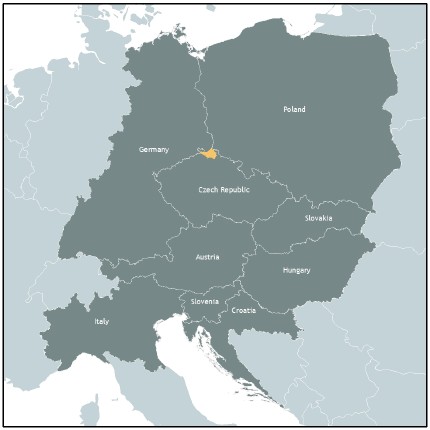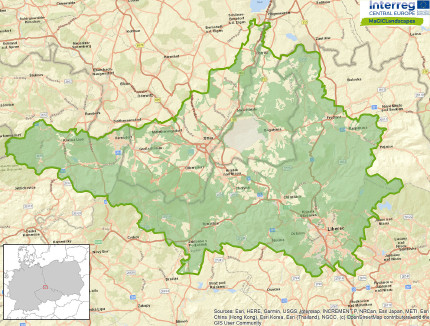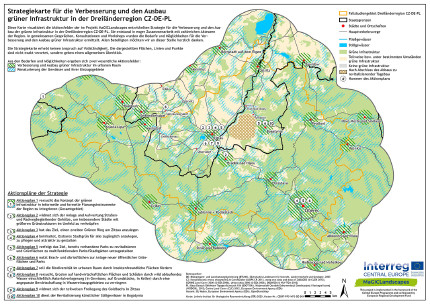Tri-border region CZ-DE-PL
Green Infrastructure Strategy and Action Plan

|

Case study area map of the case study area "Tri-border region CZ-DE-PL" |
Description of the area
The case study area of the three-border region Czech Republic-Germany-Poland stretches from Bohemian Switzerland in the west through the Zittau and Lusatian Mountains to the Iser Mountains in the east. An important landscape feature is the River Neisse and its tributaries. This network of waterways connects the three countries and passes through mountainous areas with forests, peat bogs, rocky areas and mountain meadows and the lowlands with their settlements (e.g. Zittau and Liberec) and agricultural areas. Open cast lignite mining still impacts this landscape, with the Turów mine being the largest.
Issues
The region is an important ecological corridor between the national park regions of Saxon-Bohemian Switzerland and the Giant Mountains. However, between the Zittau/ Lusatian Mountains and the Jizera Mountains, elements of green infrastructure (GI) are often not sufficiently connected. Urban and peri-urban areas are characterised by a lack of green spaces and contain abandoned or unused areas offering very few benefits. The area has a lot of straightened or channelised rivers that can increase the risk of flooding for downstream areas and the floodplains have limited biodiversity and/or multifunctionality.
Challenges
A key challenge surrounds the issue that the term GI and concept is understood very differently by different actors or is even unknown to some stakeholders in the case study area. In addition, all three countries have their own biotope network system, individual formal planning systems, each with different legal basis, and various geodata on land use, often differing in projection and content. All this currently makes cross-border planning of GI difficult. Informal planning instruments have a high potential to implement GI, but their establishment in the case study area is a further challenge.
HOW THE STRATEGY WAS DEVELOPED
Outline of key themes, priorities and directions for the GI Strategy and Action Plan
Two fields of action determine the direction of the strategy for the tri-border region. They are:
- Creation and enhancement of urban green spaces
- Restoration of watercourses, floodplains and catchment areas
All action plans are assigned to these two fields of action. Each action offers several benefits. Priority GI benefits identified for the tri-border region are 'Health & well-being', 'Education' and 'Tourism & recreation'. Key actions for these three benefits focus on the creation and improvement of green spaces in urban and rural areas. Other priority benefits include:
- the 'conservation benefits, e.g. by increasing biodiversity in the cities,
- 'land & soil management' and 'agriculture and forestry', with emphasis of actions on improved erosion control and resilient forestry, and
- 'climate change mitigation & adaptation' and 'disaster prevention', e.g. to achieve improved flood protection through the restoration of rivers and floodplains.
GI Benefit | Strategic Tools/Policies | Partners | ||
| Health & well-being | Integrated urban development concept (INSEK) Zittau Elaboration of a common development concept for the Liberec-Zittau region | Zittauer Stadtentwicklungsgesellschaft mbH Interreg SN-CZ Project 'ALiZi' | ||
| Education | Urban Gardening Initiatives Special training measures of the Employment office (motivation workshop 2.0) | "Amaliengarten" Zittau, University of Applied Sciences Zittau Görlitz (HSZG) City of Bogatynia bao GmbH - Service provider for education, work and orientation | ||
| Tourism & Recreation | Tourism concepts Application of the City of Zittau for the European Capital of Culture 2025 | International University Institute of TU Dresden (IHI) Tourism Centre Zittauer Gebirge Nature Park 6-City Association City of Zittau City of Liberec | ||
| Conservation Benefits | Biotope network systems/Natura 2000 | Agentura ochrany přírody a krajiny ČR - AOPK (CZ) Regionalna Dyrekcja Ochrony Środowiska we Wrocławiu - RDOS (PL) Saxon State Ministry for Energy, Climate Protection, Environment and the Economy - SMEKUL (DE), Lower Nature Protection Agency Landkreis Görlitz (DE) | ||
| Land & Soil Management | Participation procedure for the second comprehensive update "Regional Plan Upper Lausitz - Lower Silesia" Central network grassland management for the promotion of biodiversity in the southern district of Görlitz RAINMAN Toolbox | Regional Planning Association Upper Lusatia-Lower Silesia Landschaftspflegeverband Zittauer Gebirge & Vorland e.V. Interreg Central Europe Project 'RAINMAN' | ||
| Agriculture & Forestry | EPLR project 'Forest restructuring outside protected areas' Programme for sustainable forest management |
| ||
| Climate Change Mitigation & Adaptation | European Green Leaf Award of the European Commission | Zittauer Stadtentwicklungsgesellschaft mbH | ||
| Disaster Prevention | Cross-border cooperation of Saxony and the Czech Republic in flood risk management | Interreg SN-CZ Project 'STRIMA II' |
Key Players/actors in delivering the strategy and those that support its implementation
One of the main actors in the tri-border region is the Zittauer Stadtentwicklungsgesellschaft (Zittau Urban Development Corporation), which is incorporating the GI concept into the Integrated Urban Development Concept (INSEK) for the municipality of Zittau (DE). In addition, the Stadtentwicklungsgesellschaft Zittau is currently working with the City of Liberec (CZ) on a joint development concept for the Liberec-Zittau region as part of the "ALiZi" project, in which the results of MaGICLandscapes are also to be taken into account. The bao GmbH is another important partner in Zittau in the design of public open spaces, e.g. within the scope of special training measures of the employment office. The City of Bogatynia (PL) is already planning a number of measures that will deliver the three top priority benefits. The nature conservation authorities of all three countries (see table above) are working on the biotope network and the Natura 2000 network of protected areas.
The University of Applied Sciences Zittau-Görlitz (HSZG) as well as the International University Institute of the TU Dresden (IHI) increasingly integrate GI and its achievements into teaching and support student activities in this field, as in the case of the HSZG the urban gardening project "Amaliengarten" in Zittau. Networking with other ongoing (research) projects (e.g. RAINMAN, STRIMA II) is equally important in order to exchange and harmonize proposed measures for the region and thus to promote their implementation.
Regional representatives of the Bündnis 90/Die Grünen party act as multipliers of the GI concept in the region. In addition, a number of funding programmes are available which can support the implementation of the GI concepts in the region. One example are the small project funds, administered by the Euroregion Neisse-Nisa-Nysa, which support cross-border projects between Saxony and Poland as well as Saxony and the Czech Republic.
Expected benefits
The strategy and action plans cover two main fields of action. The field of action "Creation and enhancement of urban green spaces" aims to improve the quality of life of city dwellers and to create recreational areas and environmental education opportunities. At the same time, this is expected to increase biodiversity and improve the adaptation of cities to climate change. The field of action "Restoration of watercourses, floodplains and catchment areas" is intended to prevent future heavy flooding, reduce soil erosion in the catchment areas and increase the biodiversity of the floodplains.
Download the Dreiländereck Green Infrastructure Strategy (Deutsch)

GI Strategy Map of the Tri-border region CZ-DE-PL
Contact
Leibniz Institute for Ecological Urban and Regional Development
Marco Neubert
m.neubert(at)ioer.de
Header photo: Henriette John
Back to WP3 OVERVIEW | CASE STUDY AREA | MAIN PAGE
